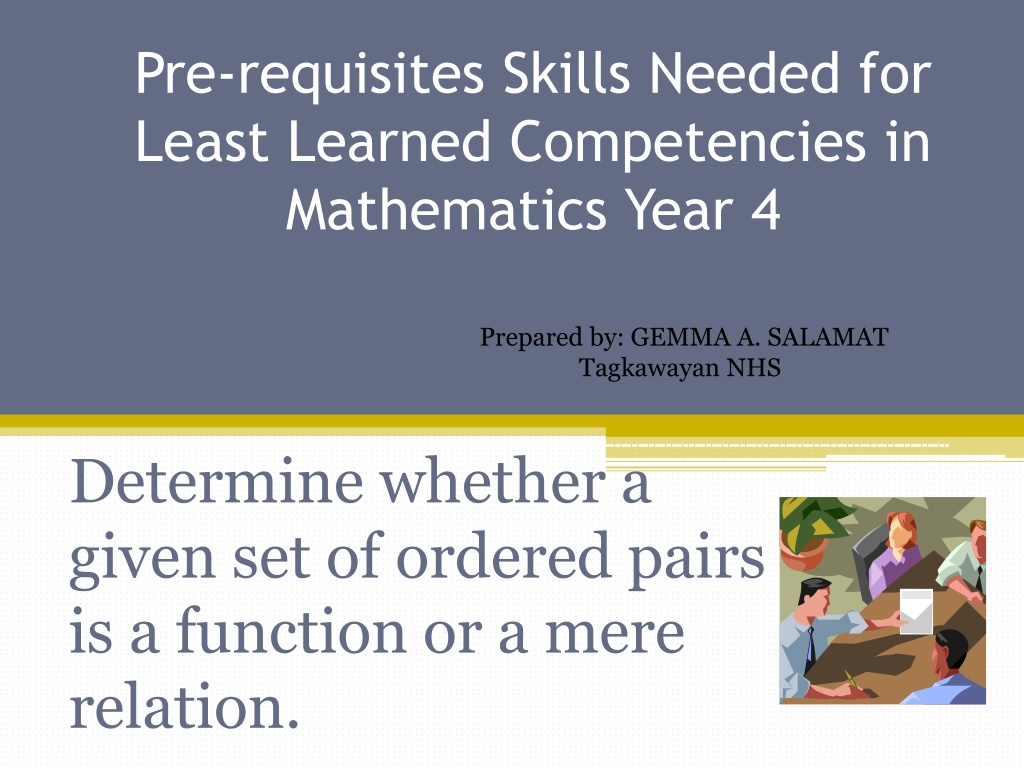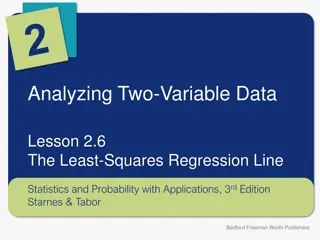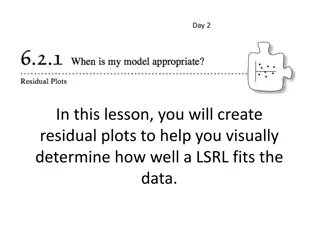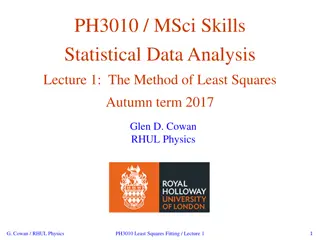
Mathematics Year 4: Developing Ordered Pair Skills
Enhance your understanding of ordered pairs in Mathematics Year 4 with activities like grouping objects, writing ordered pairs, and completing sets of ordered pairs. Learn to distinguish functions from relations and practice mapping diagrams to improve your mathematical competencies.
Download Presentation

Please find below an Image/Link to download the presentation.
The content on the website is provided AS IS for your information and personal use only. It may not be sold, licensed, or shared on other websites without obtaining consent from the author. If you encounter any issues during the download, it is possible that the publisher has removed the file from their server.
You are allowed to download the files provided on this website for personal or commercial use, subject to the condition that they are used lawfully. All files are the property of their respective owners.
The content on the website is provided AS IS for your information and personal use only. It may not be sold, licensed, or shared on other websites without obtaining consent from the author.
E N D
Presentation Transcript
Pre-requisites Skills Needed for Least Learned Competencies in Mathematics Year 4 Prepared by: GEMMA A. SALAMAT Tagkawayan NHS Determine whether a given set of ordered pairs is a function or a mere relation.
PRE-REQUISITE SKILLS WRITING AN ORDERED PAIR Description: This activity will enable you to write ordered pairs. Out of this activity, you can describe the relation of an object to its common name.
A. Direction: Group the following objects in such a way that they have common property/characteristics fork pencil laptop liquid eraser knife ballpen notebook tablet grater iPod pot cellphone paper digital camera ladle kitchen utensils school supplies gadgets
Form some ordered pairs using the format: (object, common name). a. Column 1: ___________________________ b. Column 2: ___________________________ c. Column 3: ___________________________ QUESTIONS 1. How many objects can be found in each column? 2. How did you classify the objects? 3. Based on the coordinates you have formulated, is there a repetition of the first coordinates? What about the second coordinates?
B. Description: Given a diagram, you will be able to learn how to make a set of ordered pairs. Direction: Describe the mapping diagram below by writing the set of ordered pairs. The first two coordinates are done for you. narra tulip orchid mahogany rose apricot flower tree
Set of ordered pairs: {(narra, tree), (tulip, flower), (____, ____), (____, ____), (____, ____), (____, ____)} 1. How did you make a set of ordered pairs? 2. How many elements are there in the set of ordered pairs you have made? 3. What elements belong to the first set? Second set? 4. Is there a repetition on the first coordinates? How about the second coordinates? 5. Does the set of ordered pairs represent a relation? 6. How is a relation represented?
C. Description: Given a diagram, you will be able to learn how to make a set of ordered pairs. Given the graph, complete the set of ordered pairs Set of ordered pairs: {(0, 6), (1, 5), (__, __), (__, __), (__, __), (__, __), (__, __)} How did you complete the set of ordered pairs? 1 2 3 4 5 6 7 8 9 10 0 1 2 3 4 5 6 7 8 9 10
IDENTIFYING DOMAIN AND RANGE It is noted that the domain of a relation is the set of first coordinates while the range is the set of second coordinates.
IDENTIFYING TYPES OF CORRESPONDENCE A correspondence may be classified as one-to- one, many-to-one or one-to-many. It is one-to- one if every element in the domain is mapped to a unique element in the range; many-to-one if any two or more elements of the domain are mapped to the same element in the range; or one-to-many if each element in the domain is mapped to any two or more elements in the range.
One-to-One Correspondence Student Many-to-One Correspondence ID No. Class Rank 001 025 154 Mary Susan Roger Kenneth Mary John Kim 1 3 One-to-Many Correspondence Teacher Mars Kim Sonia John Mrs. Pe as
A function is a special type of relation. It is a relation in which every element in the domain is mapped to exactly one element in the range. Furthermore, a set of ordered pairs is a function if no two ordered pairs have equal abscissas. 1. Among the types of correspondence, which ones are functions? Why? 2. Does one-to-one correspondence between elements always guarantee a function? How about many-to-one? Justify your answer. 3. Does one-to-many correspondence between elements always guarantee a function? Justify your answer.
Consider the sets of ordered pairs below. Set A: {(3, 4), (4, 5), (5, 6), (6, 7), (7, 8)} Set B:{(2, 2), (2, -2), (3, 3), (3, -3), (4, 4), (4, -4)} Set C: {(0, 1), (1, 1), (2, 1), (3, 1), (4, 1), (5, 1)} 1. What is the domain of each set of ordered pairs? 2. What is the range of each set of ordered pair
3. What type of correspondence is each set of ordered pairs? Explain. 4. Which set/sets of ordered pairs is/are functions? Explain.
Decide whether each set of ordered pairs represents a function or a mere relation. Put a tick mark on the appropriate column. Justify your answer. Set of ordered pairs Function Mere relation Reason 1. {(4, 0), (4, 1), (4, 2)} 2. {(0, -2), (1, 1), (3, 7), (2, 4)} 3. {(-2, 2), (-1, 1), (0, 0), (1, 1)} 4. {(-2, 8), (-1, 2), (0, 0), (1, 2), (2, 8)} 5. {(3, 3), (0, 0), (-3, 3)} 6. {(-2, 0), (-1, 3), (-1, - 3), (0, 2), (0, -2), (1, 3), (1, - 3 ), (2, 0)}






















